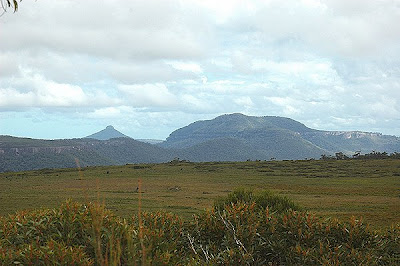 The vegetation in the foreground is sandstone heath country - very dwarf, often less than knee high. In wetter patches, it will support low shrubbery, but less than head high.
The vegetation in the foreground is sandstone heath country - very dwarf, often less than knee high. In wetter patches, it will support low shrubbery, but less than head high.We were looking for Orchids and found many signs of them although not many in flower. But the few which we did find in flower, were exciting ones, for me, as I had not seen them before.
 The first new species (for me) was Mecopodum striatum (formerly Prasophyllum striatum). This was a very pale Leek Orchid, which was quite delightful in its "purity". A lovely creamy white labellum, and purple stripes on the dorsal sepal and lateral petals. These flowers were growing in low heath shrubbery, on peaty soil over sandstone.
The first new species (for me) was Mecopodum striatum (formerly Prasophyllum striatum). This was a very pale Leek Orchid, which was quite delightful in its "purity". A lovely creamy white labellum, and purple stripes on the dorsal sepal and lateral petals. These flowers were growing in low heath shrubbery, on peaty soil over sandstone.  The second new species, for me, was the tiny "Prawn Greenhood" Crangonorchis pedoglossa (formerly Pterostylis pedoglossa). I was totally surprised by how tiny these plants were. I have seen photos of these plants, but without any scale. So when we found the first plants today, I was surprised to see that the rosettes of leaves we saw were less than a 10 cent coin in diameter. And the first flowers we saw were dried up ones, on about 60mm high stems. That means they are considerably smaller (shorter) than the Tiny Greenhoods (Speculantha sp) which we saw in considerable numbers today (as flowers just finished, or just setting seed).
The second new species, for me, was the tiny "Prawn Greenhood" Crangonorchis pedoglossa (formerly Pterostylis pedoglossa). I was totally surprised by how tiny these plants were. I have seen photos of these plants, but without any scale. So when we found the first plants today, I was surprised to see that the rosettes of leaves we saw were less than a 10 cent coin in diameter. And the first flowers we saw were dried up ones, on about 60mm high stems. That means they are considerably smaller (shorter) than the Tiny Greenhoods (Speculantha sp) which we saw in considerable numbers today (as flowers just finished, or just setting seed). Subsequently we found some fresh flowers, but even these were barely 2cm long, standing no more than 80 mm high. The fine pointed tip is so fine that it was barely visible with the naked eye (until you lay down on the ground to get a really good look at them, or to take these photographs). Even the thin "ears" (points) were very fine. These plants were growing in little patches of low vegetation, on steeply sloping sandstone rock shelves. Their aspect was south-easterly, so that would give them a little protection from the full heat of the sun, but not much. Needless to say, I was thrilled to see these exquisite little Greenhoods.
Subsequently we found some fresh flowers, but even these were barely 2cm long, standing no more than 80 mm high. The fine pointed tip is so fine that it was barely visible with the naked eye (until you lay down on the ground to get a really good look at them, or to take these photographs). Even the thin "ears" (points) were very fine. These plants were growing in little patches of low vegetation, on steeply sloping sandstone rock shelves. Their aspect was south-easterly, so that would give them a little protection from the full heat of the sun, but not much. Needless to say, I was thrilled to see these exquisite little Greenhoods. The common name of "Prawn Greenhood" is quite apt, once you see these flowers, as the point is reminiscent of the long pointed head of a Prawn, and the points remind one of the feelers of the Prawn.
The common name of "Prawn Greenhood" is quite apt, once you see these flowers, as the point is reminiscent of the long pointed head of a Prawn, and the points remind one of the feelers of the Prawn.I shall report more fully on this expedition on another occasion.

No comments:
Post a Comment